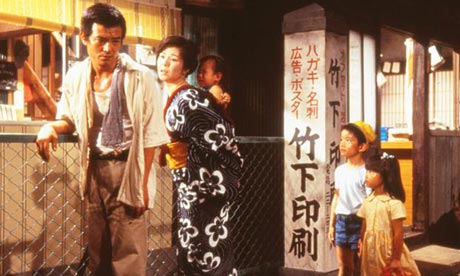
The little boy is lying back in a woman's arms. "Eat, you brat!" His screams are stifled because she is palming clods of rice into his mouth. "I said eat!" There's rice smeared about his face, in his eyelashes, his hair. She glares at her husband, who is standing impotently back. "You spoil him. I'm teaching him a lesson."
That's the first of several highly distressing scenes from Yoshitaro Nomura's 1978 melodrama The Demon, which stars Ken Ogata as a pathetic, philandering printer whose wife is outraged when his mistress dumps three illegitimate children on them. The wife initially vents her anger, then bullies him into abandoning his offspring, and worse. Scenes like the above are an utter shock to the modern cultural palate. With extreme violence ubiquitous, and porn creeping into the mainstream, they shatter what's perhaps the last remaining cinematic taboo: the direct depiction of cruelty to children.
It's not the kind of taboo film-makers rush to break: no bigger cold shower exists for a film's box-office chances than child abuse. But what's extraordinary about The Demon is not only that it got made at all, but the realism with which it depicts such grotesque deeds, and the human conclusions it supplies about them. Usually, abuse of children, when it makes it on to the screen, is safely penned into stylised genres, such as the horror of Ringu (in which Sadako of the cursed videotape is a murdered child). Or it drags more real-world dramas in that direction, as with Carrie's explosion from harried daughter into telekinetic avenger, or Mystic River's fairytale allusions to the "wolves" who destroyed Tim Robbins's character's childhood.
There's also a tendency for films to gravitate towards the blackest instances of such behaviour, ie sexual abuse. Nomura – a veteran director for Shochiku studio whose psychological acuity is being celebrated in a season at London's Institute of Contemporary Arts – said he didn't want to make a dark, dismal movie about child abuse, but wanted to present an "everyday evil": how a weak character was forced into dire circumstances. Nomura was responding to a wave of child-abandonment cases in a rapidly industrialising and socially dislocated 1970s Japan; the events of The Demon, via a 1958 short story by Nomura's regular collaborator Seichō Matsumoto, are based on a real case recounted to the author by a Tokyo detective. Hence Nomura's steadfast realism, which, apart from some Bernard Herrmann-esque trembling on the soundtrack, never wavers.
So we're confronted with scenes like the force-feeding, or its later echo when the crab-faced Ogata trembles with derangement as he attempts to cram a cyanide-laced bun into his eldest son's mouth. Which begs the question: we all know that some children's vulnerability is horribly exploited – but why watch something like that?
One answer is that such works aren't just a reminder of the banality of evil, but also of the power of images. Jonathan Glazer's Under the Skin effectively weaves unsettlingly raw frames of an abandoned child crying on the beach into its emotional tapestry, but The Demon goes further. Witnessing these acts feels like a dangerous violation, with a shocking immediacy that prose would lack. Taboo-breaking here forces us to think about what the responsible limits of representation are in a way (now that the censors rarely censor, but mostly classify) we're rarely called to do. We examine what we should show, for how long, and why.
Unlike most modern film violence, there's nothing exploitative, no sense of boundary-pushing for its own sake. Evil isn't some cheap Voldemortian blood-right here: the printer and his wife are dragged down into a hellish moral vacuum, one link leading plausibly and inexorably to the next in a chain of events too heavy for them to resist. Ogata had been understandably reluctant to play the role, but he made his character horribly sympathetic – winning a Japanese Academy award for it in the process – and it became the first in a series of trademark extreme roles. The Demon carefully humanises the printer's craven nature, suggesting he was also abandoned as a child. Whether you think this kind of moral statement is a strong enough justification for such unsparing imagery probably depends on where you stand on the political spectrum. If it's further to the right, then the real-life case might please you better: Ogata's counterpart apparently died insane in prison.
So Nomura arguably shows restraint. But it's possible he wasn't responsible in every quarter. A one-year-old couldn't possibly fake the kind of anguish displayed in that initial scene, and there's some evidence the child actors were affected by their work. The cinematographer Takashi Kawamata claims that Shima Iwashita, who played the wife, kept away from the children during shooting; when she attempted to give them presents at an early public screening, "they were frightened by seeing her, and the youngest child even started to cry". I wonder how they feel about this lone silhouette of a film nearly 40 years on. Unlike us, they'll surely never forget that, to the child inside, the image is always real.
• The Yoshitaro Nomura season is at the ICA, London from 18-23 April, with The Demon screening on 23 April. Thanks to Tom Vincent of the Bradford international film festival for background information.

